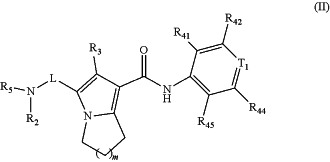| CPC C07D 487/04 (2013.01) [A61P 31/20 (2018.01)] | 20 Claims |
|
1. A compound of formula (II) or a pharmaceutically acceptable salt thereof,
 wherein,
m is 1;
L is selected from
 T1 is selected from the group consisting of N and C (R43);
R2 is selected from the group consisting of H and C1-6 alkyl, wherein the C1-6 alkyl is optionally substituted by 1, 2, or 3 Rb;
R3 is selected from the group consisting of Cl, F, Br, I, OH, NH2, C1-6 alkyl, and C1-3 alkoxy, wherein the C1-6 alkyl and the C1-3 alkoxy are optionally substituted by 1, 2, or 3 Rc;
R41, R42, R43, R44, and R45 are each independently selected from the group consisting of H, Cl, F, Br, I, OH, NH2, CN, COOH, and C1-3 alkyl, wherein the C1-3 alkyl is optionally substituted by 1, 2, or 3 Rd;
R5 is selected from the group consisting of R51, C3-10 cycloalkyl, and 3-6 membered heterocycloalkyl, wherein the C3-10 cycloalkyl and the 3-6 membered heterocycloalkyl are optionally substituted by 1, 2, or 3 R1;
R51 is selected from the group consisting of C1-7 alkyl and C1-6 heteroalkyl, wherein the C1-7 alkyl and the C1-6 heteroalkyl are optionally substituted by 1, 2, or 3 Re;
R1 is each independently selected from the group consisting of H, Cl, F, Br, I, OH, NH2, CN, COOH, C1-6 alkyl, —COO—C1-6 alkyl, and —C1-3 alkyl-COO—C1-6 alkyl, wherein the C1-6 alkyl, the —COO—C1-6 alkyl, and the —C1-3 alkyl-COO—C1-6 alkyl are optionally substituted by 1, 2, or 3 Ra;
Ra is each independently selected from the group consisting of Cl, F, Br, I, NH2, CN, COOH, C1-3 alkyl, and C1-3 alkoxy, wherein the C1-3 is optionally substituted by 1, 2, or 3 R;
Rb is each independently selected from the group consisting of Cl, F, Br, I, OH, NH2, CN, and COOH;
Re is each independently selected from the group consisting of Cl, F, Br, I, OH, NH2, CN, COOH, and C1-3 alkyl, wherein the C1-3 is optionally substituted by 1, 2, or 3 R;
Rd is each independently selected from the group consisting of Cl, F, Br, I, OH, NH2, CN, and COOH;
Re is each independently selected from the group consisting of Cl, F, Br, I, OH, NH2, CN, and COOH;
R is each independently selected from the group consisting of Cl, F, Br, I, OH, NH2, CN, and COOH; and
the C1-6 heteroalkyl and the 3-6 membered heterocycloalkyl each contain 1, 2, 3, or 4 heteroatoms or heteroatom groups independently selected from the group consisting of —NH—, —O—, —S—, and N.
|